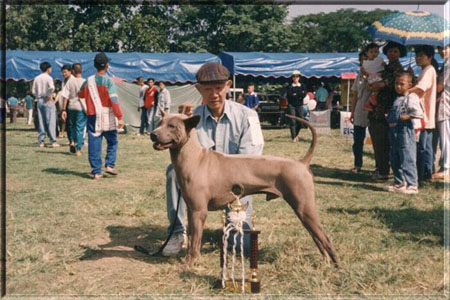back to previous page
Library
Thai Ridgeback Dog History
by Jack Sterling
The Thai Ridgeback Dog is an indigenous breed of Thailand. Its place of
origin is the eastern part of the country. Its outstanding characteristic is
fierceness and for this reason it is reared as a watch dog, because houses in
rural areas are not fenced as in towns and people stay away from home most of
the day to do farm work. In the old days, the Thais had to go out to hunt wild
animals for food, such as rabbits and deer, and needed the help of dogs because
of their speed. Since this breed has a long body and extraordinary deep chest
and a well tucked-up waist, it is classified as belonging to the hound breed.
Travelling in the days when carts were the main vehicles, people would take
their dogs along wherever they went, however faraway it is, without any
problems. In some provinces, this kind of dog was called "cart-following dog,"
serving as an escort dog. Though very fierce by nature, this Thai dog is
not so fierce once it is outside the house compound or accompanying its owner
to other places. It can be classified as a guard dog and hunting dog.
The reason why the Thai or Siamese dog is not so famous worldwide as the
Thai or Siamese cat is because city people who are well off, prefer rearing
cats to dogs. According to the book of Siamese cats by Mrs. Dunmill, in 1884,
Mr. Owen Gould took a Siamese cat along with him to England and later that cat
was a prize winner at the Crystal Palace Shows of 1890, and when contests were
held in Europe and America, Siamese cats always won first prizes. That made
Siamese cats better known than the name of the country itself. In character,
the Siamese cat excels other breeds by its love for the master and its ability
to please him. (What a coincidence that 110 years after a "Mr. Gould" brought
the first Siamese cats to England, a "Mr. Sterling" brought the first Siamese
dogs to the United States.)
�
Both the Thai/Siamese cat and the Thai/Siamese dog are domestic animals
that have been a legacy to the Thais for centuries. The Thais had ignored their
importance, not caring even to register them as members of the F.C.I., probably
because there had never been a cat or a dog association

Above: This TRD champion "Kaew Bungken" wins again at a dog show in
Chiangmai, Thailand (1994)
To handle this matter until 1975 when The Dog Association of Thailand was
established. Throughout the past decade, efforts have been made to develop the
Thailand Ridgeback dog, and the result has been beyond expectations, as the
Thailand dog is clever, fierce, freedom-loving and not approaching unless
called by its owner, thus causing no annoyance. In addition, it is a
dog easy
to tend to and to keep clean but difficult for fleas and ticks to dwell on its
skin because of its very short hair.
Since the Thais have always been characterized by the habit of adhering to and
maintaining customs and traditions, this habit has a bearing on the concept of
developing the Thai dog. For it has never been known that any owner or
breeder of dogs crossbred the Thai Ridgeback Dog with other breeds. Another
reason is the geographical features of the country. Only back in 1936,
communication between Bangkok, Thailand's capitol city, and rural areas in the
eastern region, such as Thad Province, where local people like to rear Thai
Ridgeback Dogs more than elsewhere, was such that it would take as long as two
days to travel by car. With only a handful of cars available in those days,
travelling by cart would take even months. That is the reason that indigenous
dogs in that area had less chance to mate with other breeds. Thus, the Thai
Ridgeback Dog presently found in the east has been able to preserve its race
and is one of the most genuine natural breeds of the world.
© Copyright American Thai Ridgeback Association 1995-2018
Notice: Copyright to all photographs displayed on this site is owned by the
photographer.
You may not sell, publish,
license or otherwise distribute any of these photographs without the written
permission of the photographer.
|


